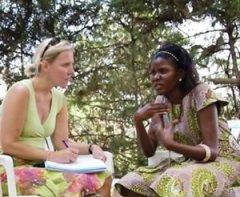Bringing medical imaging to Ugandans

The dots began to connect for Kristen VanValkenburg De Stigter ’84 while she was a Calvin student on an off-campus interim trip in Liberia.
“I was a member of the first class that went abroad with [sociology] professor Don Wilson,” said De Stigter. “We were all a little inexperienced—we got stopped by the military for taking photographs—but the overall result is that I had the sense of need thrust into me.”
On that trip, De Stigter and another pre-med student hopped on a bus and traveled to Monrovia, the capital of Liberia, to listen to a medical lecture they had seen advertised. The lecture was on Lassa fever by a professor on the staff of Case Western University in Cleveland, and that professor wound up employing De Stigter during the summers of her Calvin years, working in a parasite lab.
Attending Case Western for medical school after her Calvin graduation, De Stigter’s responsibilities grew, and she went on a number of trips to Africa, first as a medical student and later as a radiology resident.
“We were following nomadic groups of people,” De Stigter recalled, “and I would run the ultrasound machine looking for parasites. We found ourselves in a remote and dangerous place in Kenya on the border of Sudan, working on parasite research during the day and then setting up a health clinic for the local people in the evening. I noticed how helpful it was to have ultrasound technology available for a variety of medical issues, particularly for pregnant women.”
De Stigter’s experiences led to partnerships with other medical professionals, hospitals and clinics, and technology companies. In 2007, De Stigter and a colleague at the University of Vermont founded Imaging the World (ITW), an organization that develops procedures and technologies to enable medical imaging in remote regions worldwide.
“Ultrasound technology advanced from the ability to take only still pictures to the ability to take video clips, where a professional reading the images can easily read the images electronically and remotely, stopping to review and even scroll back through images as a diagnosis is pondered,” said De Stigter. “We’ve developed protocols for each kind of medical review for different parts of the body, and we figured out how to teach health care workers with little knowledge of anatomy how to take the ultrasound video clips just based on surface anatomy.”
The protocols from ITW allow the use of this technology to be sustainable anywhere. Trained persons in remote areas can take the ultrasound images, compress them 250:1 using specialized software and send them via a cell phone modem to a network of experts who return their assessment back to the sender in the field by text message.
“After a year or two, we have trained enough people who can acquire and interpret images, train others locally in the protocols and read and service the equipment. ITW can be a backup to them, but the intent is for people in-country to ‘learn to fish’ and carry on the model,” she said.
Not only are De Stigter and her teammates writing protocols and reading medical images, they are also bringing big industry partners to the table as collaborators. She has been pleased to note how typical competitors in the medical technology field, such as General Electric Healthcare and Phillips Healthcare, are sharing expertise and advice with ITW and one another to improve the technology and the delivery systems.
The organization is focusing initially on Uganda as a “proof of concept” project, with an emphasis on obstetric use. Once documented success rates are established in Uganda, other countries with similar challenges—such as Haiti and India—will be considered.
“In Uganda, there is a death-in-pregnancy rate of 1-in-22, which compares to 1-in-7,000 in the U.S. Mainly that’s due to bleeding and delays in the birth process and ultrasound technology can determine which women are susceptible to that in advance of the birth. If we know that, we can make sure those women give birth in hospitals and clinics, not at home,” said De Stigter.
In addition to her many hours and travels for ITW, De Stigter is vice chair of the radiology department at the University of Vermont and program director for the residency program in diagnostic radiology. She has four children; one of them, Kaitlin, is a Calvin graduate who is in the law program at Penn State.
“I really appreciated the encouragement of Dr. Tigchelaar in the pre-med program at Calvin,” she said. “And Professor Wilson’s advice to be ready for the thing God calls you to do was most important to me. I’ve found that listening to that call and the hands of God are making things happen.”
For more on Imaging the World, see www.imagingtheworld.org.






